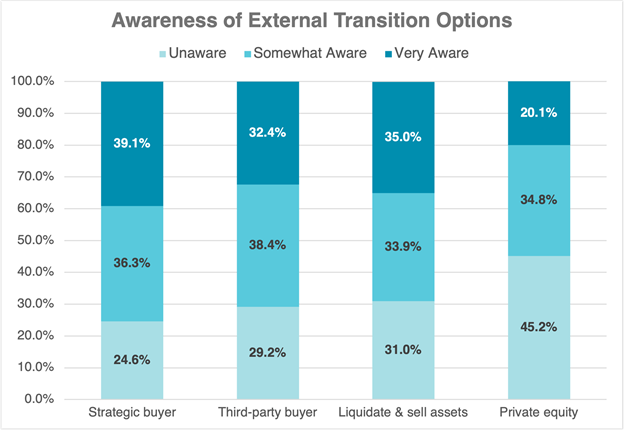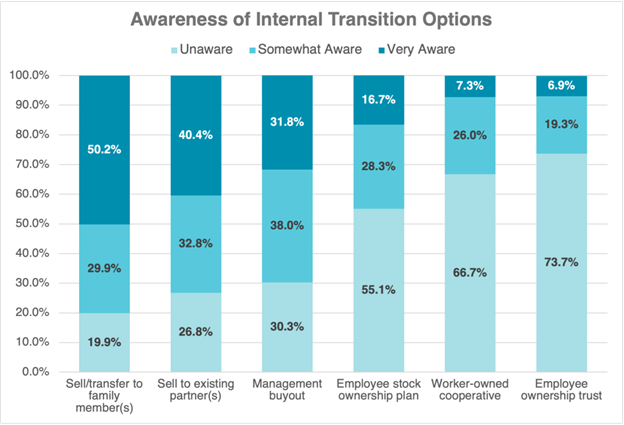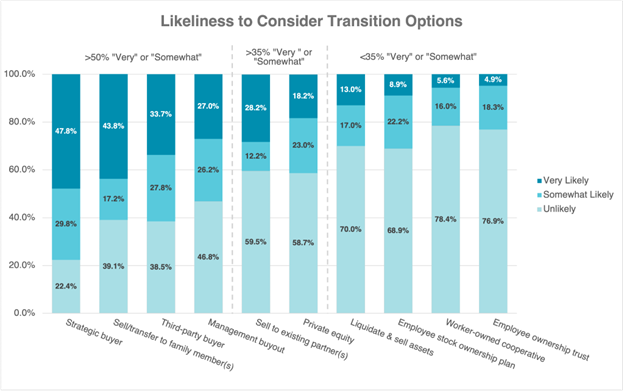Which business transition options are owners likely to pursue?
By Michael Darger
April 1, 2024
What external or internal options for transferring their business are the business owners/leaders aware of? And which of these options are they likely to pursue? Of course — if they’re not aware of an option — then they are not likely to pursue it.
These are a few of the things we are researching in the Minnesota Business Succession and Transition Study (286 owners responded to our survey).
Our findings have implications not only for important advisers like CPAs and accountants (see our
previous article), but also for people who would like to see a business stay in their community after the owner retires or departs for other reasons.
External vs. internal transition options
We asked the owners about their awareness of four external transfer options. Separately, they were asked about six internal options.
Of the external options, more than two-thirds of owners were very or somewhat aware of selling to a strategic or third-party buyer or liquidating and selling the assets. Over half were very or somewhat aware of selling to private equity (see Figure 1).
Figure 1

Here we found a clear dichotomy between selling to employees vs. non-employees. Over two-thirds were very or somewhat aware of selling to family, partners or managers. In contrast, less than half were aware or very aware of selling to employees via three of the most common pathways: ESOPs, worker cooperatives or employee ownership trusts (Figure 2).
Figure 2

Near the end of the survey, we asked how likely the owners were to consider each of the ten transfer routes. There were four buyer options that a majority selected as very or somewhat likely pathways: strategic, family, third-party or management. Strategic buyer was the clear favorite. In contrast, we found less than a third of owners were very or somewhat likely to consider any of the employee options or liquidating and selling assets.

What are the implications of these findings?
While there are several potential conclusions to draw, from my perspective as the business retention and expansion* specialist for University of Minnesota Extension, I see a couple things.
First, I believe that employee ownership is below what it could be in the Minnesota economy. The lack of awareness about three forms of employee ownership that we found makes it not surprising that we found much lower likelihood for owners to transfer to their employees than the other transfer options. The
Minnesota Center for Employee Ownership and others intend to create awareness of employee ownership.
Second, if a business transfers and distributes ownership from one or a few selling owners to several or many employee-owners, it is my hypothesis that the business is much less likely to move away from its community of origin. If true, this is valuable information for local economic development efforts.
You can find the complete research results
here. What can you do to help your business clients or other owners you know?
First, encourage them to start or continue their transition planning — they need to do it now. Our new
video collection offers two to three minute informational clips on several subjects. Playlists include
exit planning, selling owners, buying owners, employee ownership, and several more.
Second, encourage them to consult with their other trusted advisors because one adviser is not sufficient.
*Business retention and expansion is the economic development activity of paying attention to local businesses with the intention that they remain in the community and expand there. Naturally, business succession and transition planning is a related topic.
Michael Darger is an Extension community economics specialist at the University of Minnesota. He is leading a research project on Minnesota business succession and transition and facilitates a diverse group of economic and business development professionals around the state who are concerned about this topic. He manages Extension’s business transition program resources including a business owner course, a YouTube channel with short videos and more. He can be reached at darger@umn.edu.